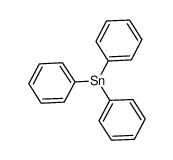Stannane, triphenyl-

Stannane, triphenyl- structure
|
Common Name | Stannane, triphenyl- | ||
|---|---|---|---|---|
| CAS Number | 892-20-6 | Molecular Weight | 350.01300 | |
| Density | 1.374 g/mL at 25ºC(lit.) | Boiling Point | 163-165ºC0.3 mm Hg(lit.) | |
| Molecular Formula | C18H15Sn | Melting Point | 28ºC(lit.) | |
| MSDS | Chinese USA | Flash Point | >230 °F | |
| Symbol |


GHS06, GHS09 |
Signal Word | Danger | |
|
Comparative toxicity of antifouling compounds on the development of sea urchin.
Ecotoxicology 20(8) , 1870-80, (2011) In the present study, embryotoxicity experiments using the sea urchin Lytechinus variegatus were carried out to better clarify the ecotoxicological effects of tributyltin (TBT) and triphenyltin (TPT) (the recently banned antifouling agents), and Irgarol and D... |
|
|
Effects of organotin alternative antifoulants on oyster embryo.
Arch. Environ. Contam. Toxicol. 61(1) , 128-34, (2011) In September 2008, organotin (Ot) compounds were prohibited from being used worldwide. From 1997 onward in Japan, the production of paints containing TBT (tributylin) compounds was prohibited, and thus alternatives to Ot antifoulants have been used since then... |
|
|
Triphenyltin induced growth inhibition and antioxidative responses in the green microalga Scenedesmus quadricauda.
Ecotoxicology 20(1) , 73-80, (2011) The toxicity of organotin compounds in the environment is closely related to their uptake by microorganisms and delivery through the food chain. The population at low trophic levels like microalgae plays an important role in this aspect. In this study, the to... |
|
|
Influence of triphenyltin exposure on the hypothalamus–pituitary–gonad axis in maleSebastiscus marmoratus
Aquat. Toxicol. 104(3-4) , 263-9, (2011) Both triphenyltin (TPT) and tributyltin (TBT) have been used as ingredients of antifouling biocides. However, far fewer studies addressing the reproductive toxicity of TPT on fishes are available than for TBT. The present study was conducted to investigate th... |
|
|
Sex-dependent aromatase activity in rat offspring after pre- and postnatal exposure to triphenyltin chloride.
Toxicology 276(3) , 198-205, (2010) Triphenyltin (TPT) is an organotin compound (OTC) previously widely used as an antifouling agent in paints applied in the marine environment, a fungicide, and as an agricultural pesticide. In female aquatic invertebrates, certain OTCs induce the so-called imp... |
|
|
Retinoid X receptor agonists modulate Foxp3⁺ regulatory T cell and Th17 cell differentiation with differential dependence on retinoic acid receptor activation.
J. Immunol. 191(7) , 3725-33, (2013) Retinoic acid (RA) enhances TGF-β-dependent differentiation of Foxp3(+) inducible regulatory T cells (iTregs) and inhibits Th17 differentiation by binding to the RA receptor (RAR)/retinoid X receptor (RXR) heterodimer. The major physiologic RA, all-trans-RA, ... |
|
|
Divergent teratogenicity of agonists of retinoid X receptors in embryos of zebrafish (Danio rerio).
Ecotoxicology 21(5) , 1465-75, (2012) Zebrafish (Danio rerio) embryos were comparably exposed to seven known agonists of retinoid X receptors (RXRs) including two endogenous compounds (9-cis-retinoic acid and docosahexaenoic acid), four man-made selective ligands (LGD1069, SR11237, fluorobexarote... |
|
|
Stage-specific malformations and phenotypic changes induced in embryos of amphibian (Xenopus tropicalis) by triphenyltin.
Ecotoxicol. Environ. Saf. 74(7) , 1960-6, (2011) Tributyltin (TBT) and triphenyltin (TPT) can induce unique malformations in embryos of amphibian (Xenopus tropicalis). We further exposed X. tropicalis embryos to TPT during different stages. Severe malformations were observed in the embryos after exposure to... |
|
|
Utilization of nSiO2, fly ash, and nSiO 2/fly ash composite for the remediation of triphenyltin (TPT) from contaminated seawater.
Environ. Sci. Pollut. Res. Int. 20(11) , 8172-81, (2013) The removal of triphenyltin chloride from contaminated simulated seawater with adsorption method was discussed. The adsorbents used are fly ash, nSiO2, and nSiO2/fly ash composite. The results showed that the adsorption of the adsorbents increases with increa... |
|
|
Fluorescence spectroscopic investigation of the interaction between triphenyltin and humic acids.
Spectrochim. Acta. A. Mol. Biomol. Spectrosc. 78(3) , 1018-22, (2011) The interaction between triphenyltin (TPT) and humic acid (HA) was investigated using UV-vis and fluorescence spectra techniques. The experimental results showed that the fluorescence quenching of HA by TPT was a result of the interaction of TPT with HA. The ... |